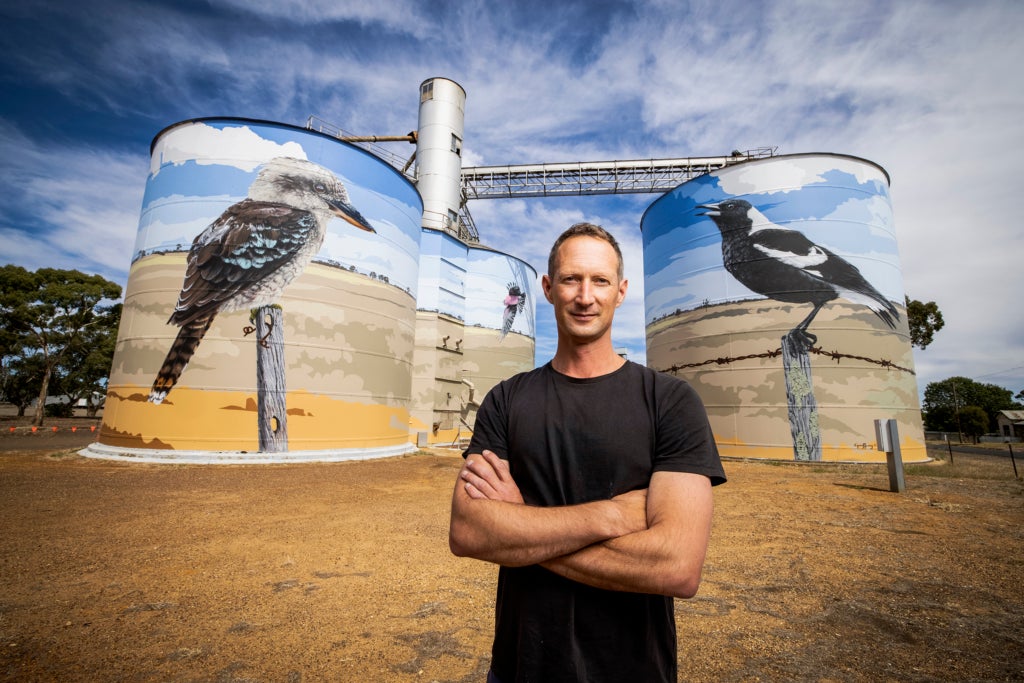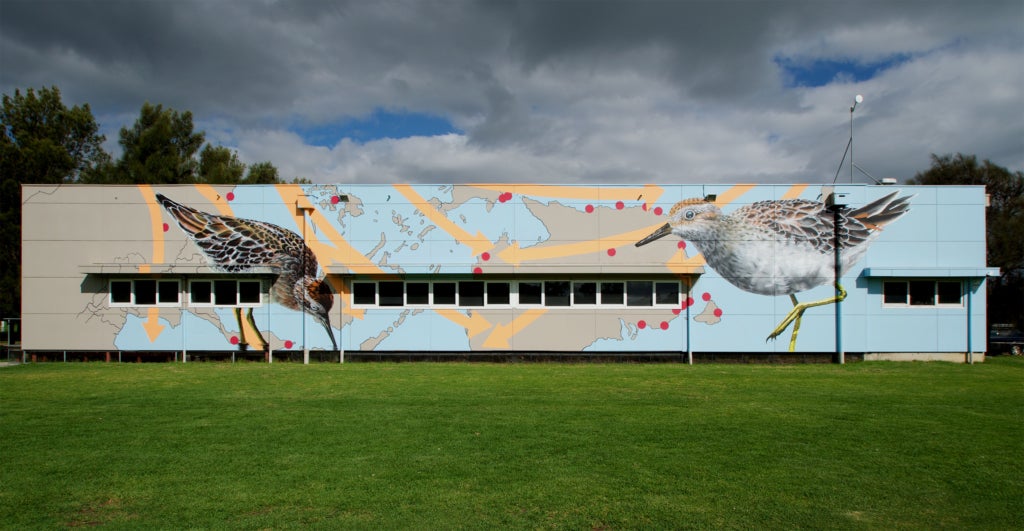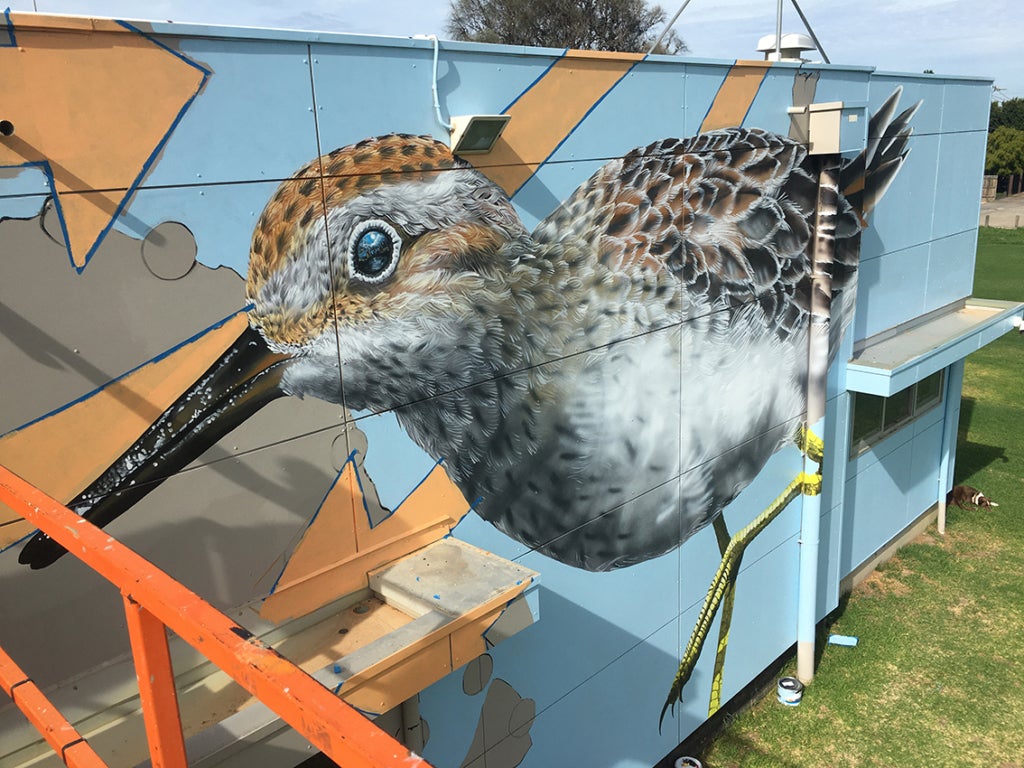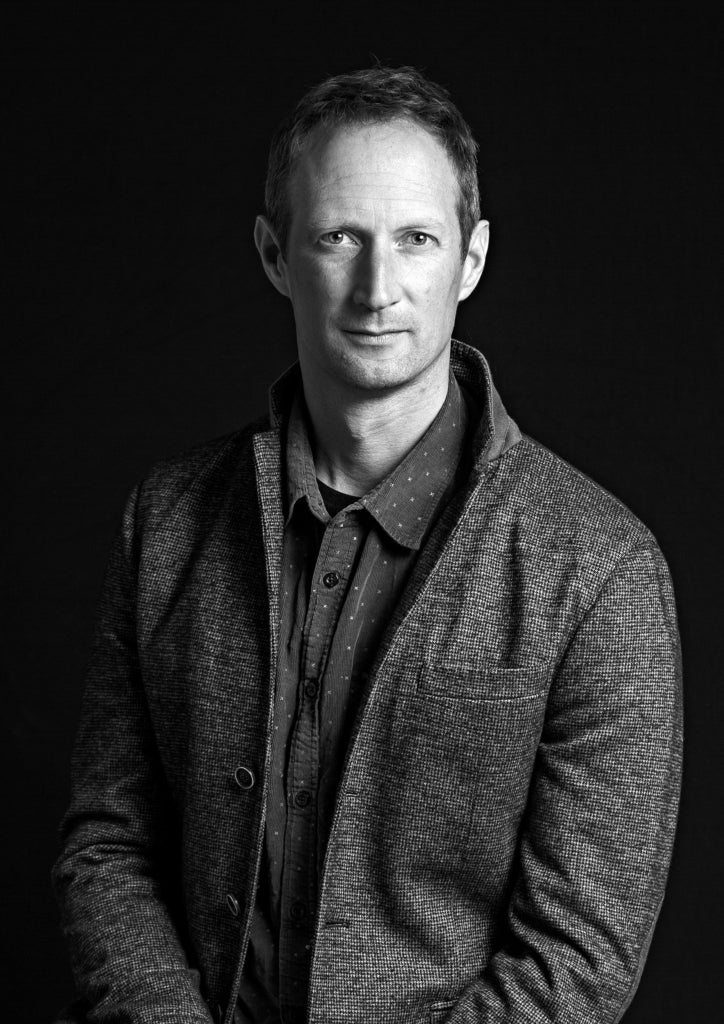Across Australia, Carran’s Murals of Birdlife Explore Human Identity and Connection to Place
Lily Robinson
This artist profile is one in an ongoing series highlighting the role creative work plays in connecting people with nature and inspiring a culture of stewardship. If you are an artist whose work is inspired by nature and would like to be featured in a future ILCN newsletter, please reach out to lrobinson@lincolninst.edu. We will accept visual fine art, photography, poetry, personal essays, music, and more.

The richness of flora and fauna endemic to Australia is unmatched anywhere in the world. About 85 percent of the nation’s plants are unique to the continent and half the world’s marsupial species are at home there. But one class of animals stands out most to artist Geoffrey Carran. Among this tapestry of vibrant biodiversity, he notices a special connection between people and native birds. “Everyone over here has a story about the birdlife,” he said.
Carran is a painter and muralist whose work is informed by Australian biodiversity and its connection to human identity. He specializes in hyper-realistic large-scale public works featuring avian species that are scientifically and culturally accurate and that communicate stories of habitat change, past and present.
Birds and art may have been destined to converge at the center of Carran’s career. Being an artist was always a given to him. Growing up in an artistic family, he was encouraged to fill huge chalkboards with drawings. From a similarly early age, he was fascinated by the brilliant birdlife around him.

Carran was raised in New Zealand where birds play a particularly strong role as ecosystem custodians. The island nation evolved free of mammals—though introduced species have since taken root there, driving its proportion of threatened native species higher than anywhere else in the world—elevating both the ecological and cultural importance of its diverse and highly unique bird populations.
Due to its lack of indigenous mammalian predators, New Zealand also has a large number of flightless birds, meaning that there are distinct avian populations on the ground, in the subcanopy, and in the canopy itself. “It’s fascinating to see how that whole ladder of ecological niches is filled with different birds,” said Carran.
After completing an undergraduate arts degree in New Zealand, Carran moved to Australia, where he began working as a landscaper. There, spending his days entwined with the landscape, his curiosity for the nation’s biodiversity was piqued. “Everywhere I went there seemed to be these unique endemics and I started putting that into my artwork”.
As he became intimately aware of Australia’s biodiversity, he also noticed how much it faded into the background for others. “[Many local people] weren’t noticing the species that were unique to where they were,” he said. Carran saw a way to draw their attention back toward the richness of life in their own backyards: public art that depicted nature in stunning full color and with intricate scientific accuracy.
As he worked on projects on-the-ground in communities, he spoke to the people living in those places. In hearing their stories, he became curious about how local flora and fauna inform human narratives. “I started looking at the plants and [asking] can identity be wrapped up in or affected by the local environment where people are residing?”

The inquiry spurred a series on endemic flora, but soon led him in a new direction. “People do have such a strong affinity to the birdlife over here. It’s very present, it’s in your face, it’s loud, and there’s a lot of personality there.”
Once he stepped down that path, Carran found a wealth of information to explore on birds as a cultural phenomenon connecting people to place. For the next 15 years, the topic centered his work.
Today, his paintings are larger than life and often displayed on conspicuous canvases. Murals of iconic, strikingly feathered avians are washed over walls of buildings, urban spaces, and shipping containers. One wraps a water tank nestled in the foothills of Mount Buller and another three splay across a trio of grain silos rising from a rural agricultural landscape.
Locals have been quick to engage with Carran’s work. Particularly with his larger installations, he said, “the communities really take ownership of the artwork, and they take pride in it.” His public works are always place specific, depicting species that reside in the region where the painting goes up. People recognize that connection. “It becomes a real talking point or a sense of public identity for them.” People take out-of-town visitors to the murals and use them as landmarks.
When locals see him creating artwork in their community, they often have something to share with Carran. “They really do open up and start telling you about their own relationships with bird life.” Regardless of their connection to the species he is painting, people will come to Carran to tell him their bird stories. Often, these are stories of change. Due mainly to the introduction of foreign species and habitat loss, Australia has lost more mammal species than any other continent; from 1985-2020, its threatened and near-threatened bird populations declined 60 percent; and its biodiversity continues to diminish more rapidly than peer nations’.

In 2020 Carran painted his “Seasonal Migrants Mural”, commissioned by the Kingston City Council. The piece stands in the Edithvale-Seaford Wetlands, a designated Ramsar site spanning 261 hectares (about 645 acres) near Melbourne. Once part of the larger, 4,000-hectare (9884-acre) Carrum Carrum Swamp, the area was drained for farming in the late 1800s. Only the Edithvale-Seaford Wetlands remain, engineered and maintained to provide flood protection for surrounding development and now, to support the surviving species that call it home.
“Seasonal Migrants” explores the migratory roots of the sharp-tailed sandpiper, an Asian shorebird that travels from Siberia to Australia and New Zealand each fall. The Edithvale-Seaford Wetlands support one percent of the species’ total global population. Some who saw Carran paint the mural also remember the unfolding of the landscape’s many chapters. “A lot of these residents have actually seen it turn from discarded agricultural land into a thriving, rehabilitated wetland and noticed the species returning,” he said.
While his public works are occasionally accompanied by descriptive plaques, most speak for themselves. Viewers for whom the pieces spark further interest can learn more on social media, which has been catalytic for visibility and spreading conversation. “I’ve also noticed this phenomenon of people actually going out and seeking out specific artworks just to document them and share them on their social media platforms, and that opens up another level of discussion about the artwork.”
Carran’s largest work to date is part of the Australian Silo Art Trail, a nationwide mural initiative aimed at rejuvenating economic vitality and honoring the culture and history of communities. In six weeks, he adorned three grain silos in the rural town of Goroke with native birds. A laughing kookaburra, a magpie, and a galah now each peer out over the agricultural fields of Victoria’s West Wimmera region. The kookaburra and magpie each perch on the posts of a wire fence, like the kind that commonly spans the region’s fields, while the latter soars against a vast blue, cloud-marbled sky.
“They [the birds] all represent different components of the town,” said Carran. He had approached the project with thoughts for which species he would portray but pivoted after speaking with community members. “They had a different idea about their identity,” he said, and he chose to honor that. Goroke translates to magpie in the local Indigenous language, Wotjobaluk; galahs are ubiquitous to the area and thrive on the grains grown by crop farmers; and kookaburras—a type of kingfisher—were historically attracted to the region’s once thriving seasonal wetlands and are still common in the area.
Carran loved working on such a large canvas. “I wanted them to be ornithologically correct, because I had the opportunity to put in so much detail at that scale.” He played with how the view would appear from different distances. Each feather was large enough to accommodate detailed filament and rich colors.
The cultural impact of the silo murals rocked the small town almost immediately after Carran put down his brush. “[Goroke had] a local population of about 140 people, and no one really traveled through there,” he said. “Within a week of me finishing the silos, the caravan park was full, and there’s just a constant trickle of people coming through.” Now, he said, every weekend brings a parade of viewers, eager to gaze up at the murals and to later find their way into local businesses for food, drink, and shopping.
While part of the rationale behind installations along the Silo Art Trail is to revitalize local economies, Carran said the near-immediate influx of visitors to Goroke was startling to residents. “They’re used to having a very quiet town with no one there and then all of a sudden there were just people … coming into town constantly.” But the people of Goroke got over the initial shock. “They embraced it pretty rapidly,” said Carran.
Across all his works, Carran said he garners strong community responses. He attributes that partially to the role social media plays in helping raise pieces’ visibility and spark conversation, but also to the strong sense of pride locals have for the species in their region. This elevates the educational and social power of his work as an advocacy tool.
“Art is a very strong way to showcase, to educate, and to raise awareness of biodiversity loss,” said Carran. “It’s a really easy way to communicate, visually, concerns in the locations that it’s happening.”

It also allows people to engage with difficult topics at their own pace and eliminates many common barriers to understanding. “It doesn’t necessarily need specific language, or jargon … you can avoid the rhetoric, and you can just put the facts out there or really clearly express a whole lot of complex issues in one artwork that people then engage with.”
Carran has several new projects on the horizon, this time exploring the relationship between land-use change and endemic bird species. He has been leaning into publicly available data sources that show patterns of change in bird populations over time across Australia, such as BirdLife Australia’s annual bird count, a citizen science project that provides updated snapshots of local bird populations and their long-term trends.
“It’s just fascinating, the way birds can tell you—if you pay attention to the trends—what the health of the land [is],” said Carran. “They’re a bit of a litmus test”.

More About the Artist
Geoffrey Carran is a painter and muralist with over 15 years of professional experience. He has a master’s in fine arts from the Royal Melbourne Institute of Technology. His murals can be found around the world from West Wimmera, Australia, to New York, Istanbul, and London. He also works on smaller-scale pieces and commissions that can be viewed on his website. Carran currently lives in Jan Juc, Australia, about an hour and a half south of Melbourne. The region is a hotspot for creatives and outdoor enthusiasts, especially surfers, like himself. Recently he has been taking some time away from commissions to give himself space to experiment, challenge himself, and develop new techniques by doing some “work that doesn’t work”.
Have news? Share updates from your organization or country by emailing ilcn@lincolninst.edu.
